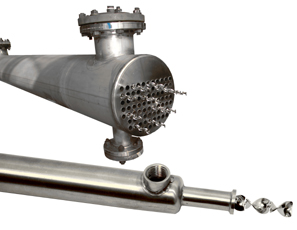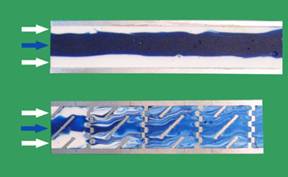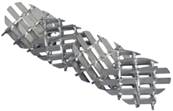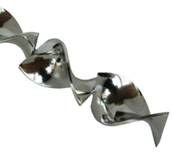
| Heat Exchanger Static Mixers | |
 Figure #1: Multi-tube (top) and monotube (bottom) Heat Exchanger static mixers. |
StaMixCo manufactures static mixer heat exchangers for enhancing heat transfer in laminar flow applications. They are used for both the heating and cooling of viscous materials. Monotube Heat Exchangers Multi-tube Heat Exchangers |
Principles of Operation When cooling or heating viscous materials in an empty tube, this laminar flow profile dramatically impedes heat transfer. Static mixing elements, when inserted into a tube processing viscous materials will exchange wall and bulk fluid material and enhance heat transfer by a factor of 3 to 6 depending on the type of static mixing element used, the tube size and process conditions. |
|
 Figure #2: Laminar flow in an empty tube (top) and through an X-Grid type static mixer (bottom)
|
|
Advantages of Static Mixer Heat Exchangers
Types of Static Mixing Elements Suitable for Viscous Heat Transfer There are three (3) fundamental types of static mixing elements that are used for enhancing heat transfer in laminar flow applications. Each design has specific advantages and disadvantages depending on process requirements. They are described below. |
|
Type GX Heat Transfer Static Mixer |
|
 Figure #3: Type GX static mixer |
The GX mixing elements are generally used in monotube and multi-tube configurations in tubing sizes 1” - 6” diameter. |
Type GX-L Heat Transfer Static Mixer |
|
 Figure #4: GX-L static mixer |
The GX-L static mixer has the same fundamental X-Grid crossing bar structure as the GX static mixer (Figure #3), but is a more open structure with a gentler angle of the mixing plates relative to the pipe axis. The GX-L design is generally used in both monotube and multi-tube heat exchanger configurations where the tubing size varies from 3/ 4” – 3” diameter. |
Type HT Heat Transfer Static Mixer |
|
 Figure #5: Type HT Helical Twist static mixer |
The HT helical twist static mixer, with alternating right-and-left twist bowties, will generally be the most cost effective heat exchanger design where heat transfer is the only requirement. Additional process requirements such as mixing and residence time distribution may require the use of GX or GX-L static mixers. The HT helical twist design is generally used in both monotube and multi-tube heat exchanger configurations where the tubing diameters are 1” and smaller. |
| More Information Technical Bulletin (pdf 74 kb) Customer Specification Questionnaire (PDF 60 kb) |
|
Request A Quote | Mixer Selection Guide | Site Map
Mexico & South America: StaMixCo-Mexico; Geranios 26, J del Alba; C. Izcalli; 54750 Estado de Mexico; Tel: 52 (55) 2876 2311
USA & Canada: StaMixCo LLC; 235-84th Street; Brooklyn, New York 11209 U.S.A.: Tel: (718) 748-4600
Europe, Asia-Pacific, Africa: StaMixCo Technology Ltd.; Ebnetstrasse 8; CH-8474 Dinhard, Switzerland: Tel: +41 52 338 17 11
© 2008 StaMixCo, LLC. | Powered by Register.com